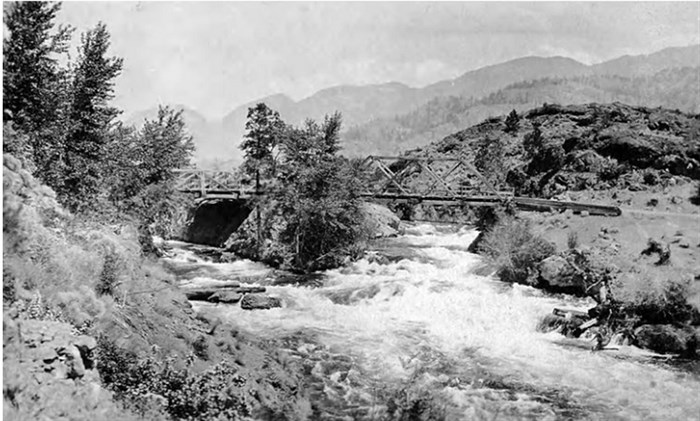
This photo of the falls at Okanagan Falls was taken by Hedley resident Harry Barnes on July 1, 1919.
Image Credit: Submitted/Hedley Museum
August 20, 2022 - 6:00 AM
There’s a town in the South Okanagan named after waterfalls that no longer exist and its former name is based entirely on a misunderstanding of what the word Skaha means to indigenous syilx people.
Welcome to Okanagan Falls, formerly known as Dogtown (or Dog Town). At one time, the town of 2,500 people today, was envisioned to be a major city at the south end of Skaha Lake, with plans for hotels, schools and a university.
Edna Badgley explains all this interesting history in the 1964 edition of the Okanagan Historical Society.
“In the days of the Indians, Okanagan Falls was believed to have been a large camping and trading site,” she wrote in a style expected at the time. “It was one of the best canoe routes to the Columbia River and the Pacific. The salmon run brought salmon in abundance to the foot of the falls and, until a few years ago, evidence of their drying and smoking racks could be found along the river banks.”
Residents originally called it Dogtown after what we know as Skaha Lake, but it appears there was plenty of confusion and poor interpretation from the Indigenous Okanagan language over whether Skaha meant dog or horse. We weren’t successful at getting a proper interpretation from current syilx sources, but if these tales are true, they may have all been confused.
The 1948 issue of the Okanagan Historical Society details origins of names throughout the region. While it says Dog Lake was the original name for Okanagan Falls, it also carries a disclaimer.
“Okanagan Indians say ‘skaha’ is not their word for dog but is that of the Shuswaps and that the local word for dog is chokowapee," the report says. "Another spelling is kaekuwapa. The local meaning of skaha is horse. That is also the meaning in the Nicola dialect."
Firstvoices.com lists the nsyilxcen word for horse as kewap. The closest thing to the word dog listed in its online dictionary is “my dog” which is inkekwap. (Some of the letters in the words are only the Anglicized versions).
The B.C. Government Place Names website does show that Skaha Lake was listed as Dog Lake on maps dating back to 1887 but was never officially recognized as that. Even so, it was formally registered as Skaha Lake in 1930.
READ MORE: IN PHOTOS: Here’s why there’s a never-ending war over the road in Kalamalka Lake park
There is no indication on just when Dogtown became Okanagan Falls.
But, in those days there was actually “beautiful tumbling double falls in Okanagan River, just below Skaha Lake’s outlet,” Badgley wrote in the historical society article.
Around 1891 Tom Ellis, who was instrumental in the development of Penticton, travelled to Oregon and established a syndicate, made up mostly of W.J. Snodgrass, to develop Okanagan Falls, she wrote.
“Mr. Snodgrass came in the spring of 1892 and fell in love with Okanagan Falls,” Badgley wrote. “Its situation at the foot of Skaha Lake, with rugged Peach Cliff standing as a sentinel on its eastern borders and the mountains falling back on all sides, gives it a setting that is unique and beautiful. Here he envisioned a city of considerable size in this setting of natural beauty.”
That year, a townsite was laid out that included locations for parks, schools, hotels, a city hall and university.
Snodgrass developed a stage and freight line from Penticton down to Grand Forks, with steamboats plying the waters of Skaha Lake.
By the turn of the century, however, neighbouring mines were closing and ore was being shipped more often on the Great Northern Railroad in Washington state.
“Mr. Snodgrass’ dream of a city at the south end of Skaha Lake began to fade,” Badgley wrote. “The stagecoach and freightlines had reduced operations and, in 1908, Mr. Snodgrass sold his store.”
There was little growth in the community until after the Second World War.
Following a major flood in 1948, the Okanagan Lake Regulation System was built between 1950 and 1958 at a cost of almost $5 million.
Only about five kilometres of the 35 km Okanagan River channel from Okanagan Falls to Osoyoos was left in a natural state, according to the Okanagan Nation Alliance, which started restoring the river back to a more natural state in 2000.
Part of that “channelization” of the river included the blasting and virtual removal of the Okanagan Falls waterfalls that gave the community its current name.
See the full Okanagan Historical Society article here.
READ MORE: Dream of connecting Okanagan's rail trails to new Washington state trail still alive
To contact a reporter for this story, email Rob Munro or call 250-808-0143 or email the editor. You can also submit photos, videos or news tips to the newsroom and be entered to win a monthly prize draw.
We welcome your comments and opinions on our stories but play nice. We won't censor or delete comments unless they contain off-topic statements or links, unnecessary vulgarity, false facts, spam or obviously fake profiles. If you have any concerns about what you see in comments, email the editor in the link above.
News from © iNFOnews, 2022